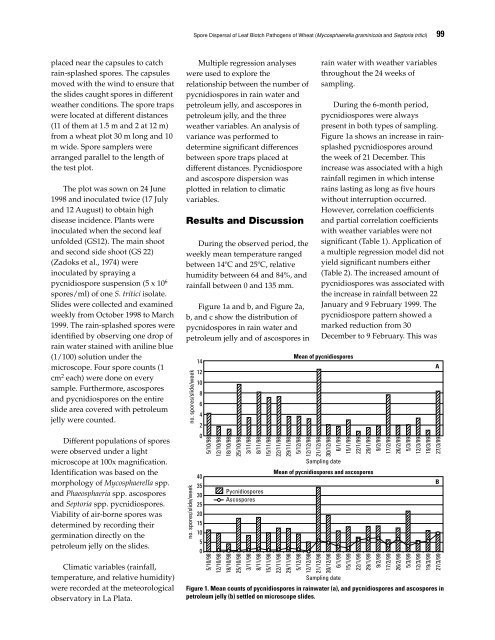Septoria and Stagonospora Diseases of Cereals - CIMMYT ...
Septoria and Stagonospora Diseases of Cereals - CIMMYT ...
Septoria and Stagonospora Diseases of Cereals - CIMMYT ...
Create successful ePaper yourself
Turn your PDF publications into a flip-book with our unique Google optimized e-Paper software.
placed near the capsules to catch<br />
rain-splashed spores. The capsules<br />
moved with the wind to ensure that<br />
the slides caught spores in different<br />
weather conditions. The spore traps<br />
were located at different distances<br />
(11 <strong>of</strong> them at 1.5 m <strong>and</strong> 2 at 12 m)<br />
from a wheat plot 30 m long <strong>and</strong> 10<br />
m wide. Spore samplers were<br />
arranged parallel to the length <strong>of</strong><br />
the test plot.<br />
The plot was sown on 24 June<br />
1998 <strong>and</strong> inoculated twice (17 July<br />
<strong>and</strong> 12 August) to obtain high<br />
disease incidence. Plants were<br />
inoculated when the second leaf<br />
unfolded (GS12). The main shoot<br />
<strong>and</strong> second side shoot (GS 22)<br />
(Zadoks et al., 1974) were<br />
inoculated by spraying a<br />
pycnidiospore suspension (5 x 10 6<br />
spores/ml) <strong>of</strong> one S. tritici isolate.<br />
Slides were collected <strong>and</strong> examined<br />
weekly from October 1998 to March<br />
1999. The rain-splashed spores were<br />
identified by observing one drop <strong>of</strong><br />
rain water stained with aniline blue<br />
(1/100) solution under the<br />
microscope. Four spore counts (1<br />
cm 2 each) were done on every<br />
sample. Furthermore, ascospores<br />
<strong>and</strong> pycnidiospores on the entire<br />
slide area covered with petroleum<br />
jelly were counted.<br />
Different populations <strong>of</strong> spores<br />
were observed under a light<br />
microscope at 100x magnification.<br />
Identification was based on the<br />
morphology <strong>of</strong> Mycosphaerella spp.<br />
<strong>and</strong> Phaeosphaeria spp. ascospores<br />
<strong>and</strong> <strong>Septoria</strong> spp. pycnidiospores.<br />
Viability <strong>of</strong> air-borne spores was<br />
determined by recording their<br />
germination directly on the<br />
petroleum jelly on the slides.<br />
Climatic variables (rainfall,<br />
temperature, <strong>and</strong> relative humidity)<br />
were recorded at the meteorological<br />
observatory in La Plata.<br />
Spore Dispersal <strong>of</strong> Leaf Blotch Pathogens <strong>of</strong> Wheat (Mycosphaerella graminicola <strong>and</strong> <strong>Septoria</strong> tritici) 99<br />
Multiple regression analyses<br />
were used to explore the<br />
relationship between the number <strong>of</strong><br />
pycnidiospores in rain water <strong>and</strong><br />
petroleum jelly, <strong>and</strong> ascospores in<br />
petroleum jelly, <strong>and</strong> the three<br />
weather variables. An analysis <strong>of</strong><br />
variance was performed to<br />
determine significant differences<br />
between spore traps placed at<br />
different distances. Pycnidiospore<br />
<strong>and</strong> ascospore dispersion was<br />
plotted in relation to climatic<br />
variables.<br />
Results <strong>and</strong> Discussion<br />
During the observed period, the<br />
weekly mean temperature ranged<br />
between 14ºC <strong>and</strong> 25ºC, relative<br />
humidity between 64 <strong>and</strong> 84%, <strong>and</strong><br />
rainfall between 0 <strong>and</strong> 135 mm.<br />
Figure 1a <strong>and</strong> b, <strong>and</strong> Figure 2a,<br />
b, <strong>and</strong> c show the distribution <strong>of</strong><br />
pycnidospores in rain water <strong>and</strong><br />
petroleum jelly <strong>and</strong> <strong>of</strong> ascospores in<br />
no. spores/slide/week<br />
no. spores/slide/week<br />
14<br />
12<br />
10<br />
8<br />
6<br />
4<br />
2<br />
0<br />
40<br />
35<br />
30<br />
25<br />
20<br />
15<br />
10<br />
5<br />
0<br />
5/10/98<br />
12/10/98<br />
5/10/98<br />
12/10/98<br />
18/10/98<br />
25/10/98<br />
3/11/98<br />
8/11/98<br />
Pycnidiospores<br />
Ascospores<br />
18/10/98<br />
25/10/98<br />
3/11/98<br />
8/11/98<br />
15/11/98<br />
22/11/98<br />
15/11/98<br />
22/11/98<br />
29/11/98<br />
5/12/98<br />
29/11/98<br />
5/12/98<br />
12/12/98<br />
12/12/98<br />
rain water with weather variables<br />
throughout the 24 weeks <strong>of</strong><br />
sampling.<br />
During the 6-month period,<br />
pycnidiospores were always<br />
present in both types <strong>of</strong> sampling.<br />
Figure 1a shows an increase in rainsplashed<br />
pycnidiospores around<br />
the week <strong>of</strong> 21 December. This<br />
increase was associated with a high<br />
rainfall regimen in which intense<br />
rains lasting as long as five hours<br />
without interruption occurred.<br />
However, correlation coefficients<br />
<strong>and</strong> partial correlation coefficients<br />
with weather variables were not<br />
significant (Table 1). Application <strong>of</strong><br />
a multiple regression model did not<br />
yield significant numbers either<br />
(Table 2). The increased amount <strong>of</strong><br />
pycnidiospores was associated with<br />
the increase in rainfall between 22<br />
January <strong>and</strong> 9 February 1999. The<br />
pycnidiospore pattern showed a<br />
marked reduction from 30<br />
December to 9 February. This was<br />
Mean <strong>of</strong> pycnidiospores<br />
21/12/98<br />
30/12/98<br />
Sampling date<br />
21/12/98<br />
30/12/98<br />
6/1/99<br />
15/1/99<br />
6/1/99<br />
15/1/99<br />
22/1/99<br />
29/1/99<br />
Mean <strong>of</strong> pycnidiospores <strong>and</strong> ascospores<br />
Sampling date<br />
22/1/99<br />
29/1/99<br />
9/2/99<br />
17/2/99<br />
9/2/99<br />
17/2/99<br />
26/2/99<br />
5/3/99<br />
26/2/99<br />
5/3/99<br />
12/3/99<br />
19/3/99<br />
12/3/99<br />
19/3/99<br />
Figure 1. Mean counts <strong>of</strong> pycnidiospores in rainwater (a), <strong>and</strong> pycnidiospores <strong>and</strong> ascospores in<br />
petroleum jelly (b) settled on microscope slides.<br />
A<br />
27/3/99<br />
B<br />
27/3/99









